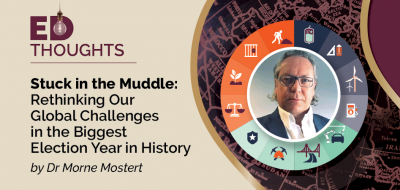Tourism in Namibia is booming. The accolades are flooding in. In March 2019, Namibia was awarded the Best Destination Safari and Wildlife at the Pacific Areas Travel Writers Association (PATWA) awards at Berlin’s Internationale Tourismus-Börse – the world’s largest tourism and trade fair. Additionally, its Environment and Tourism Minister was named Tourism Minister of the Year in the Emerging Destination category.
The relatively small country has one of Africa’s fastest-growing tourism sectors, with a reputation for being a global leader in conservation and sustainable development. This trajectory is set to continue into 2020, and it provides ample evidence of how a country can unlock opportunities through sustained community partnerships. Going forward, the question will be how Namibia will groom its leadership to keep its podium position in the tourism industry and equip the sector for the digital era. Plus, what lessons other countries can learn from this?
In the World Travel and Tourism Council’s 2018 report, it was found:
- The total GDP contribution of Travel and Tourism (T&T) to Namibia’s GDP in 2017 was 13.8%. By 2028, this is predicted to be 15.6%.
- In 2017, T&T’s total contribution to employment equated to directly and indirectly supporting 98 000 jobs. By 2028, this should rise to 137 000.
So, what is Namibia getting so right?
- Firstly, it’s always prioritised the protection of the environment. It was the first African country to write habitat and natural resources conservation into its constitution.
- Secondly, it relies heavily on community partnerships. In 1996, legislation was passed to allow communities to create conservancies. These empower local people to conserve the environment and wildlife to catalyse income. Any funds generated from conservancies are circulated in the community.
- Thirdly, the Community Based Natural Resource Management (CBNRM) was established to sustainably conserve and manage natural resources by giving communities rights to tourism and wildlife management.
From an environmental and community standpoint, Namibia is progressive. In fact, close to half the country is now protected from a conservational standpoint. The recent receipt of the award shows this is paying off. The country has established itself as a world-class tourism hot-spot. However, there’s more to be done.
Mannfred Goldbeck, author of Gondwana History, believes even more value can be unlocked in this sector. He believes that Namibia needs the following to take its travel and tourism to the next level:
- More diversity and black business ownership and representation at leadership level.
- More opportunity for education and up-skilling to accelerate transformation and instil new digital-age skills.
- Better infrastructure and social and economic development.
- Continuous marketing of ‘Brand Namibia’ to keep international tourists interested.
- Incentives for more areas to be grown into tourism income generators. Currently the western region, Etosha and Zambezi account for 75% of all tourism activity.
So, what’s next for the conservation nation?
Now in what Goldbeck calls the consolidation phase, Namibia’s tourism sector needs strong leadership to build on and sustain its successes. Jimmy Linskey, General Manager of Africa at USB-ED, says these are some of the lessons for those in tourism roles in Namibia and around the world:
- Private sector leadership: Namibia’s Tourism Minister is doing a sterling job, but the private sector needs to continue to support his initiatives and play an equal role in partnering with and up-skilling local communities. There are excellent examples of these partnerships at work, for example, Wilderness’ Serra Cafema Camp is run in partnership with the Marienfluss Conservancy, owned by the Himba people.
- Further diversification in terms of business ownership and representation at leadership level: Young people, especially, need to be groomed for positions of leadership and management in the tourism sector from a young age. Mentorship programmes would help accelerate diversification and improve succession planning to have more of a transformational focus.
- Community leadership development: It’s imperative that communities are given access to executive education opportunities, as they continue to develop their conservancies into viable, sustainable business ventures.
- Re-skilling for the digital age: It’s vital that training and continuous learning opportunities are made accessible across the tourism sector to ensure individuals are re-skilled to thrive in a time of digitisation and globalisation. This means training people to operate systems streamlining internal efficiencies – like tracking ‘bed’ occupancies and spotting seasonal dips to know when to push marketing efforts.
- More marketing: Tourism sector leaders also need to drive sustained marketing efforts to make Namibia visible as a destination of choice. From a conservancy standpoint, community leaders need to be up-skilled to market their lodges and offerings online, to a global audience.
USB-ED offers myriad courses equipping leaders at every level in businesses across all industries. If you’re in the tourism sector and wishing to ready yourself to manage a team in a time of machine-learning, you might want to consider the Management Development Programme.
written by





